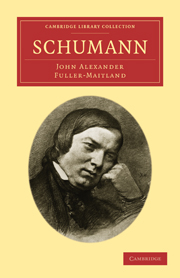Book contents
- Frontmatter
- PREFACE
- Contents
- CHAPTER I THE TWENTY YEARS' WAR
- CHAPTER II THE ARTIST'S DEVELOPMENT
- CHAPTER III THE SHADOW OF DEATH
- CHAPTER IV THE PIANOFORTE WORKS
- CHAPTER V SONGS, CONCERTED AND ORCHESTRAL WORKS
- CHAPTER VI CHORAL, NARRATIVE, AND DRAMATIC WORKS
- CHAPTER VII SCHUMANN THE CRITIC
- CHAPTER VIII SCHUMANN AND HIS CRITICS
- CHRONOLOGICAL TABLE OF ROBERT SCHUMANN'S LIFE AND WORKS
- INDEX
CHAPTER II - THE ARTIST'S DEVELOPMENT
Published online by Cambridge University Press: 29 August 2010
- Frontmatter
- PREFACE
- Contents
- CHAPTER I THE TWENTY YEARS' WAR
- CHAPTER II THE ARTIST'S DEVELOPMENT
- CHAPTER III THE SHADOW OF DEATH
- CHAPTER IV THE PIANOFORTE WORKS
- CHAPTER V SONGS, CONCERTED AND ORCHESTRAL WORKS
- CHAPTER VI CHORAL, NARRATIVE, AND DRAMATIC WORKS
- CHAPTER VII SCHUMANN THE CRITIC
- CHAPTER VIII SCHUMANN AND HIS CRITICS
- CHRONOLOGICAL TABLE OF ROBERT SCHUMANN'S LIFE AND WORKS
- INDEX
Summary
1830—1843.
“Out of weakness made strong.”
In the summer and autumn of 1830 Schumann's prospects, which in the event proved so illusory, were at their brightest. With the dearest wish of his heart realized, released from the obnoxious studies, and free to follow that vocation for which he imagined that he was best fitted, he saw himself on the threshold of a glorious career, and felt that when he had once overcome those technical difficulties connected with the pianoforte, which were as yet insuperable by him, he would be ready to launch himself into the great world of music. He determined to put himself in the hands of his old teacher, Wieck, and with that object went back to Leipzig, where he was fortunate enough to obtain rooms in Wieck's own house, Griinmaische Gasse, No. 36. Here he remained until the autumn of 1832. He soon, however, became discontented with his rate of progress, and fondly imagined that he could arrive at the desired perfection by a royal road of his own invention. He gave up his lessons with Wieck and pursued his plan in entire secrecy. Though the exact details of the invention were never revealed, it is known what were its object and mode of operation. In order to gain equality of strength and independence in all the fingers, he fastened the third finger, the weakest of all, in a strained position, and then practised diligently with the others.
- Type
- Chapter
- Information
- Schumann , pp. 13 - 26Publisher: Cambridge University PressPrint publication year: 2011First published in: 1884



